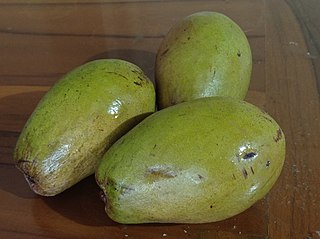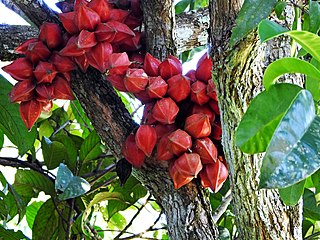
The sun bear is a species in the family Ursidae occurring in the tropical forests of Southeast Asia. It is the smallest bear species, standing nearly 70 cm (28 in) at the shoulder and weighing 25–65 kg (55–143 lb). It is stockily built, with large paws, strongly curved claws, small, rounded ears and a short snout. The fur is generally short and jet black, but can vary from grey to red. The sun bear gets its name from its characteristic orange to cream-coloured chest patch. Its unique morphology—inward-turned front feet, flattened chest, powerful forelimbs with large claws—suggests adaptations for climbing.

Dipterocarpaceae is a family of 16 genera and about 695 known species of mainly lowland tropical forest trees. Their distribution is pantropical, from northern South America to Africa, the Seychelles, India, Indochina, Indonesia, Malaysia and Philippines. The greatest diversity of Dipterocarpaceae occurs in Borneo.

Mangifera caesia is a species of flowering plant in the cashew family, Anacardiaceae. Known in English as jack or white mango, among other names. It belongs to the same genus as the mango and is widely cultivated in areas of Indonesia, Malaysia, Singapore, Brunei, Papua New Guinea and the Philippines.

Anisoptera costata is an endangered species of plant in the family Dipterocarpaceae. The specific epithet costata means "ribbed", referring to the prominent venation of the leaf blade. A huge emergent tree up to 65 m high, it is found in evergreen and semi-evergreen lowland tropical seasonal forests of Indo-Burma and in mixed dipterocarp forests of Malesia.

The chestnut-hooded laughingthrush is a species of bird in the laughingthrush family Leiothrichidae endemic to Borneo. Described by the British ornithologist Richard Bowdler Sharpe as a distinct species in 1879, it was subsequently considered a subspecies of the chestnut-capped laughingthrush until 2007, when it was again raised to species status by the ornithologists Nigel Collar and Craig Robson. It is 22–24 cm (8.7–9.4 in) long, with a chestnut brown head and chin, with grey feathering on the top of the head. The upperparts and the side of the neck are slaty-grey, with a long white wing patch. The throat, breast, and upper belly are dull yellowish-brown, with purer grey flanks and a reddish-brown vent, lower belly, and thighs. It has a yellow half eye-ring behind and below the eye, while the tail has a blackish tip. Both sexes look similar, while juveniles are duller than adults.
Durio kinabaluensis, also known as mountain durian and (locally) as durian tapuloh, is a forest tree in the mallow family.
Bouea oppositifolia, also known as plum mango, kundang, kundangan or remenia, is a species of flowering plant, a fruit tree in the mango family, that is native to Indochina and Southeast Asia.
Mangifera griffithii is a species of flowering plant, a fruit tree in the mango family, that is native to Southeast Asia.
Mangifera torquenda is a species of flowering plant, a fruit tree in the mango family, that is native to Southeast Asia.
Willughbeia angustifolia is a species of flowering plant, a woody monoecious vine in the dogbane family, that is native to Southeast Asia.
Garcinia nitida, also known as kandis hutan, is a species of flowering plant, a dioecious understorey fruit tree in the mangosteen family, that is native to Southeast Asia.
Artocarpus teysmannii, also known as cempedak air in Malay and as tilap in Indonesia, is a species of flowering plant, a fruit tree in the fig family, that is native to Southeast Asia.

Baccaurea angulata, also known as belimbing hutan or belimbing darah in Malay and more locally as ucong or embaling, is a species of flowering plant, a fruit tree in the tampoi family, that is native to Southeast Asia.

Baccaurea tetrandra, also known as mata kunau in Malay and more locally as kunau-kunau or enkuni, is a species of flowering plant, a tropical forest fruit-tree in the tampoi family, that is native to Southeast Asia.
Heliciopsis artocarpoides, also known as kurunggu or putat, is a species of flowering plant, a tropical forest fruit-tree in the macadamia family, that is native to Southeast Asia.

Lepisanthes alata, also called the Johore tree, blimbing cina, ceri or engkili, is a species of flowering plant, a tropical forest fruit-tree in the lychee family, that is native to Southeast Asia.
Lepisanthes multijuga is a species of flowering plant, a tropical forest fruit-tree in the lychee family, that is native to Southeast Asia.
Nephelium maingayi, also known as serait in Malay, mujau in Iban, and buah sungkit in Sabah and Brunei, is a species of flowering plant, a tropical forest fruit-tree in the rambutan family, that is native to Southeast Asia.
Nephelium papillatum is a species of flowering plant, a tropical forest fruit-tree in the rambutan family, that is endemic to Borneo.
Hornstedtia havilandii, also known as panyun or telidus, is a species of flowering plant, a perennial tropical forest herb in the ginger family, that is endemic to Borneo.









